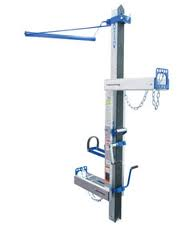 Using aluminum pump jack scaffolding is one of the most efficient ways to do any type of work on a house. Jobs where scaffolding is essential include painting, carpentry, masonry and exterior cleaning.
Using aluminum pump jack scaffolding is one of the most efficient ways to do any type of work on a house. Jobs where scaffolding is essential include painting, carpentry, masonry and exterior cleaning.
Be sure to adhere to all OSHA rules for erecting pump jack scaffolding, using equipment with two positive gripping mechanisms for a secure grip. Do not try to improvise scaffold platforms. Workbenches and other items not intended for the purpose should not be used.
Make sure to secure the bottoms of the poles to prevent slipping, and use adequate attachment to the side of the building to keep the framework from swaying. If wooden poles are used, they should be inspected beforehand for warped grain or knots that could compromise strength. If poles with these defects are found, they should not be used.
When the pump jack scaffolding is set up, you have uninterrupted access to over 500 square feet of the building. Provide planks that seem wider than you need; you will need them. The walk plank can be up to 24 feet wide, which will increase productivity by giving workers a large walking surface. The aluminum pump jack scaffold can go up to 48 feet high, providing plenty of vertical space for almost any job.
The jack machinery works like a car jack. A manual lever moves up the length of a toothed rod with a ratchet mechanism that locks after each tooth. Each pole will have one of these mechanisms, and all the jacks on a scaffold must be advanced at the same rate. Using two 24-foot long planks and two 24-foot tall poles, you start at the ground and work your way to the top of the poles. When the desired height is reached, double locking braces grip the pole and prevent the ratchet from sliding.
The rear plank acts as a guardrail and also a workbench to hold tools and materials. Do not allow the walkway to become cluttered with tools and wires. It is recommended that the safety net be used to prevent tools and people from falling.
